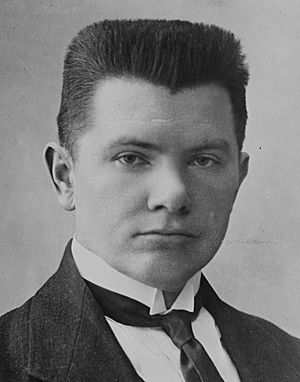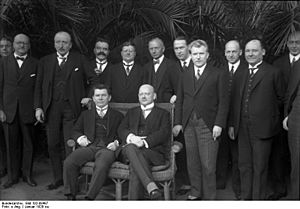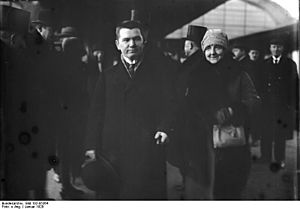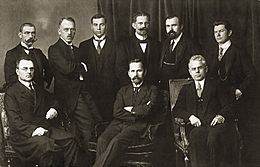Augustinas Voldemaras facts for kids
Quick facts for kids
Augustinas Voldemaras
|
|
|---|---|
 |
|
| Prime Minister of Lithuania | |
| In office 11 November 1918 – 26 December 1918 |
|
| Succeeded by | Mykolas Sleževičius |
| In office 17 December 1926 – 23 September 1929 |
|
| Preceded by | Mykolas Sleževičius |
| Succeeded by | Juozas Tūbelis |
| Minister of Foreign Affairs | |
| In office 11 November 1918 – 19 June 1920 |
|
| Prime Minister | Himself Mykolas Sleževičius Pranas Dovydaitis Ernestas Galvanauskas |
| Succeeded by | Juozas Purickis |
| In office 17 December 1926 – 23 September 1929 |
|
| Prime Minister | Himself |
| Preceded by | Mykolas Sleževičius |
| Succeeded by | Juozas Tūbelis |
| Minister of Defense | |
| In office 11 November 1918 – 24 December 1918 |
|
| Prime Minister | Himself |
| Succeeded by | Mykolas Velykis |
| Personal details | |
| Born | 16 April 1883 Dysna, Sventsyansky Uyezd, Vilna Governorate, Russian Empire |
| Died | 16 May 1942 (aged 59) Moscow, Russian SFSR, Soviet Union |
| Political party | Party of National Progress (1916–1924) Lithuanian Nationalist Union (1924–1929) |
| Spouse | Matilda Voldemarienė |
| Alma mater | Saint Petersburg Imperial University |
Augustinas Voldemaras (born April 16, 1883 – died May 16, 1942) was an important political leader in Lithuania. He was the country's first Prime Minister for a short time in 1918. He also served as the Minister of Foreign Affairs until 1920. In this role, he represented Lithuania at big international meetings like the Versailles Peace Conference.
After some time teaching at a university, Voldemaras returned to politics in 1926. He became Prime Minister again after a military takeover (called a coup d'état) in December 1926. He was a great speaker and led a strong nationalist group. However, he often disagreed with President Antanas Smetona. Smetona removed Voldemaras from his job in 1929. Later, Voldemaras was arrested and sent away from Lithuania. He died in Moscow while being held by Soviet authorities.
Contents
Early Life and Education
Augustinas Voldemaras was born on April 16, 1883, in a village called Dysna. This area is now part of Lithuania. Even though his family was not rich and didn't have much education, Augustinas was a very good student. He finished school in nearby Tverečius and then a three-year school in Švenčionys.
In 1890, he moved to Saint Petersburg, Russia, to live with his brother. In 1902, he passed exams to enter a high school (gymnasium) and finished with honors in 1904. While preparing for these exams in 1901, Voldemaras met Antanas Smetona. Smetona became his close friend and political partner, but later they became rivals.
In 1909, Voldemaras earned a degree in History and Philosophy from the Saint Petersburg Imperial University. The next year, he received his Master's Degree and a gold medal for his special project. He even got a scholarship to continue his studies and later earned his PhD. After studying in Italy and Sweden, Voldemaras returned to the university in 1915 as a staff member. He later became a professor in Perm, Russia, but he wanted to return to Lithuania.
Political Career
Becoming a Politician
Voldemaras first got involved in politics when he was a student in Saint Petersburg. Many Lithuanians living in the Russian Empire wanted their country to be independent. Voldemaras joined the Party of National Progress in 1916. He represented Lithuanian students at important meetings in Russia, like the Petrograd Seimas in 1917.
In 1918, he represented Lithuanian interests at the peace talks for the Treaty of Brest-Litovsk. This treaty was between Germany and Soviet Russia. Even though Lithuania was not officially part of the talks, Voldemaras tried to speak for his country.
In 1918, Voldemaras finally came back to Lithuania. He was asked to join the Council of Lithuania, which was working to make Lithuania independent. In September 1918, Voldemaras and Smetona helped unite different Lithuanian groups behind the Council. After Germany lost World War I, it recognized Lithuania's independence. The Council of Lithuania then chose Augustinas Voldemaras to be the first Prime Minister of Lithuania.
Leading the Government
Voldemaras became Prime Minister on November 11, 1918. He also took on two other important jobs: Minister of Foreign Affairs and Minister of Defense. His main goal was to make Lithuania stable and avoid conflicts with other countries. However, he faced many challenges.
On November 23, he signed the order to create the Lithuanian armed forces. But his choice for Deputy Minister of Defense was not popular. This person was dismissed in December 1918.
Voldemaras and President Smetona left Lithuania on December 21, 1918. They wanted to get a loan from Germany and attend the Versailles Peace Conference. But many people in Lithuania thought they were running away from the Soviet army. Because of this, Voldemaras was replaced as Prime Minister on December 26, 1918.
Even though he was no longer Prime Minister, Voldemaras continued as Minister of Foreign Affairs. He stayed in Versailles, representing Lithuania. He and his team worked hard to get other countries to recognize Lithuania's independence and its borders. They also sought help against the Bolsheviks (Soviet forces). However, they found little support from the major world powers.
In June 1920, Voldemaras and his government resigned. This made way for a new government chosen by elections. Voldemaras then went back to teaching at the university.
Return to Power and the Coup
Even while teaching, Voldemaras kept writing political articles. He often criticized the government. In 1926, Voldemaras was elected to the Seimas (Lithuanian parliament). He strongly disagreed with President Kazys Grinius and his government. Voldemaras believed Lithuania needed a stronger, more powerful government.
In 1926, some army officers who disliked Grinius's policies planned a military takeover. They asked Voldemaras and Antanas Smetona, who were now leaders of the Lithuanian Nationalist Union, for their support. Both agreed. The takeover happened on December 17, 1926. Grinius was removed, and Smetona became president again. Voldemaras was appointed Prime Minister for the second time.
To calm people down, Grinius agreed to appoint Voldemaras as Prime Minister. He asked Voldemaras to promise to follow the 1922 constitution. Voldemaras made this promise, but he and Smetona broke it within a year. They closed the parliament and didn't call new elections. In 1928, they even replaced the old constitution with a new one without following the proper rules. This made the Christian Democrats leave the government, leaving only the Nationalist Union in power.

Voldemaras also became the Minister of Foreign Affairs again. He saw foreign relations as very important. In January 1928, he signed a border agreement with Germany. In this agreement, Germany accepted that Klaipėda (Memel) belonged to Lithuania. A trade agreement was also signed with the United Kingdom that year.
Around 1926-1927, an organization called Geležinis Vilkas (Iron Wolf) was formed. It was made up of right-wing army officers and students. It was officially a youth sports group, but it was very nationalistic. Its goal was to fight against what they saw as enemies of the state. Even though Smetona was the honorary head, Voldemaras was very active in leading it. His strong personality and speaking skills attracted many young nationalist officers. These officers liked the idea of fascism, which was becoming popular in Europe. They were also unhappy with Smetona's more moderate approach. Foreign representatives in Lithuania, however, found Voldemaras too extreme and arrogant.
Challenges and Removal from Power
The activities of Geležinis Vilkas and Voldemaras's extreme views caused problems between him and Smetona. By early 1929, Smetona was already planning to remove Voldemaras from the government.
On May 6, 1929, someone tried to kill Voldemaras. As he, his wife, and friends were going to a theater in Kaunas, they were shot at. Voldemaras and his wife were not hurt, but his assistant was killed, and his nephew was seriously injured. Three students were accused of the attack, and one was punished. This attack brought a lot of public support for Voldemaras, making it hard for Smetona to dismiss him right away. But it also pushed Voldemaras to get even more involved with Geležinis Vilkas.
On September 19, 1929, while Voldemaras was at a meeting of the League of Nations, President Smetona removed him from power. Smetona appointed his brother-in-law, Juozas Tūbelis, as the new Prime Minister. In 1930, Voldemaras was sent away to live under police watch.
In June 1934, some officers who supported Voldemaras tried to overthrow Smetona. This attempt was unsuccessful. Voldemaras was then put in prison for four years. He was later set free on the condition that he leave the country. He chose to go to France.
Later Life and Death
Voldemaras tried to return to Lithuania in 1939, but he was sent away again. In June 1940, after the Soviet Union took over Lithuania, Voldemaras and his wife tried to return from France. He was arrested at the border and put in prison. It was later found out that he died in Moscow's Butyrka prison on May 16, 1942. His burial place is unknown. A memorial stone for him was placed in the Petrašiūnai cemetery in Kaunas in 2012.
Other Activities and Personal Life

While in Perm, Russia, Voldemaras taught different subjects like Roman history, Greek, Latin, and English at what is now Perm State University. After his time in government, he returned to teaching in 1920. He became a professor and dean at the University of Lithuania (now Vytautas Magnus University) in Kaunas. His academic work was highly praised. He knew sixteen different languages and wrote academic papers in Lithuanian and French.
In 1919, Voldemaras met Matilda Voldemarienė. In 1929, the couple became the godparents to three-year-old Valdas Adamkus, who later became the President of Lithuania.
See also
 In Spanish: Augustinas Voldemaras para niños
In Spanish: Augustinas Voldemaras para niños



